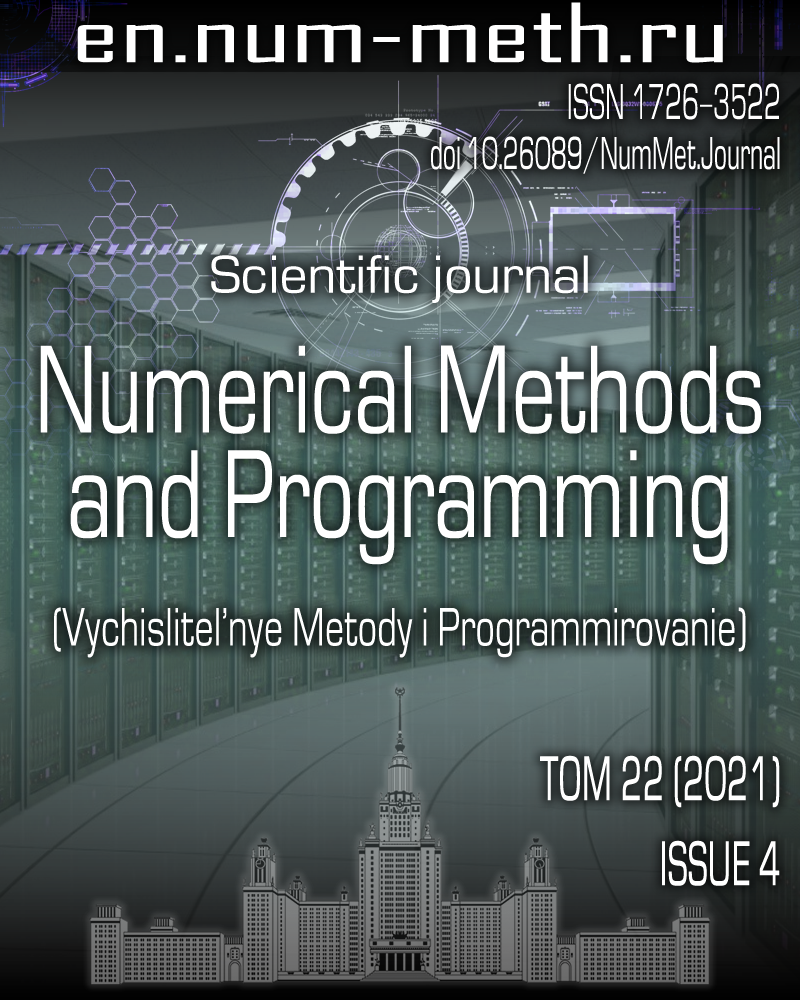DOI: https://doi.org/10.26089/NumMet.v22r418
Algorithms of motion in the particle-in-cell method
Keywords:
Abstract
in electromagnetic fields and compares this method with various known modifications of the Boris method. The created two-dimensional and three-dimensional algorithms are based on the use of an exact solution of the differential equation for the velocity of a charged particle at a time step. A comparative analysis of the Boris method and its modifications was carried out both in terms of the accuracy of the methods and the time of their operation. A new modification of the Boris method allows more accurate calculations of the trajectory and velocity of a charged particle without a significant increase in the complexity of calculations. It is shown that, when choosing a modification of the Boris method to solve a problem, one should pay attention first of all to the accuracy of the solution, since a simpler and faster scheme may not give a gain in time.
Published
Issue
Section
References
- F. H. Harlow, “The Particle-in-Cell Computing Method for Fluid Dynamics,” in Methods in Computational Physics: Advances in Research and Applications (Academic Press, New York, 1964), Vol. 3, pp. 319-345.
- Yu. A. Berezin and V. A. Vshivkov, The Particle-in-Cell Method in Rarefied Plasma Dynamics (Nauka, Novosibirsk, 1980) [in Russian].
- J. P. Boris, “Relativistic Plasma Simulation-Optimization of a Hybrid Code,” in Proc. 4th Conf. on Numerical Simulation of Plasmas, Washington, DC, USA, November 2-3, 1970 (Naval Res. Lab., Washington, DC, 1971), pp. 3-67.
- C. K. Birdsall and A. B. Langdon, Plasma Physics via Computer Simulation (McGraw-Hill, New York, 1985; Energoatomizdat, Moscow, 1989).
- H. Qin, S. Zhang, J. Xiao, et al., “Why is Boris Algorithm so Good?’’ Phys. Plasmas 20 (2013).
doi 10.1063/1.4818428 - T. Umeda, “A Three-Step Boris Integrator for Lorentz Force Equationof Charged Particles,” Comput. Phys. Commun. 228, 1-4 (2018).
doi 10.1016/j.cpc.2018.03.019 - T. Umeda, “Multi-Step Boris Rotation Schemes for Lorentz ForceEquation of Charged Particles,” Comput. Phys. Commun. 237, 37-41 (2019).
doi 10.1016/j.cpc.2018.11.001 - S. Zenitani and T. N. Kato, “Multiple Boris Integrators for Particle-in-Cell Simulation,” Comput. Phys. Commun. 247 (2019).
doi 10.1016/j.cpc.2019.106954 - S. Zenitani and T. Umeda, “On the Boris Solver in Particle-in-Cell Simulation,” Phys. Plasmas 25 (2018).
doi 10.1063/1.5051077 - B. Ripperda, F. Bacchini, J. Teunissen, et al., “A Comprehensive Comparison of Relativistic ParticleIntegrators,” Astrophys. J. Suppl. Ser. 235 (2018).
doi 10.3847/1538-4365/aab114 - M. Winkel, R. Speck, and D. Ruprecht, “A High-Order Boris Integrator,” J. Comput. Phys. 295, 456-474 (2015).
doi 10.1016/j.jcp.2015.04.022 - J. Qiang, “High Order Numerical Integrators for Relativistic Charged Particle Tracking,” arXiv: 1702.04486v1 [physics.acc-ph] (2017).
- N. A. Krall and A. W. Trivelpiese, Principles of Plasma Physics (McGraw-Hill, New York, 1973; Mir, Moscow, 1975).
- D. Potter, Computational Methods in Physics (Wiley, New York, 1973; Mir, Moscow, 1975).
- I. S. Berezin and N. P. Zhidkov, Computational Methods (Fizmatgiz, Moscow, 1962; Pergamon, Oxford, 1965).
License
Copyright (c) 2021 Екатерина Сергеевна Воропаева, Константин Витальевич Вшивков, Людмила Витальевна Вшивкова, Галина Ильинична Дудникова, Анна Анатольевна Ефимова

This work is licensed under a Creative Commons Attribution 4.0 International License.


